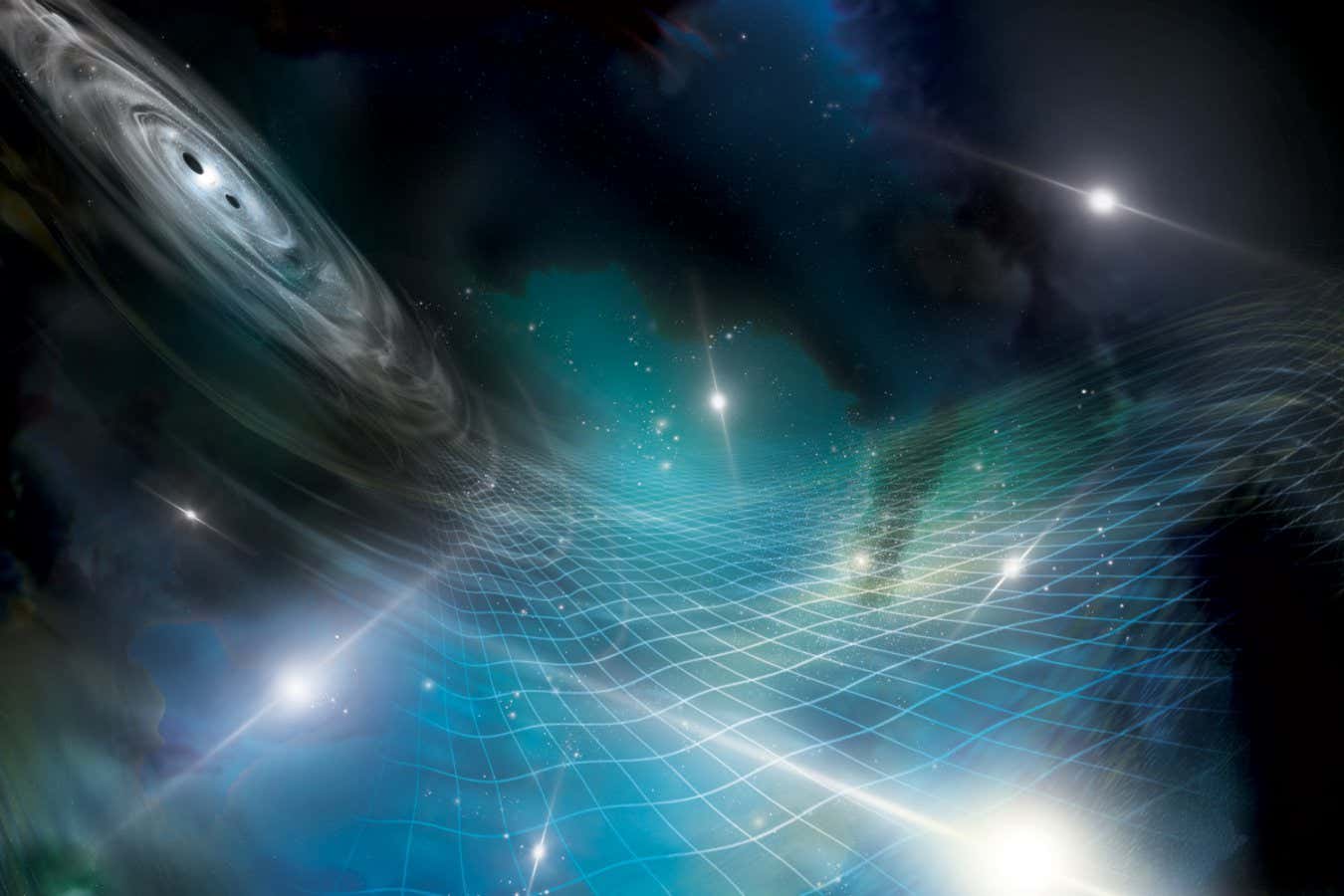Pulsars have helped reveal ripples in space-time throughout the universe
NANOGrav
Astronomers have discovered a background buzz of gravitational waves that indicates that the fabric of the universe is constantly rippling. These waves can be produced by supermassive black holes merging across the universe, but they might also have more exotic origins, such as leftover ripples in space-time created shortly after the big bang. Understanding the true nature of these waves could provide insight into how supermassive black holes grow, how they affect their host galaxies, and even how the universe evolved in its early stages.
To detect this mysterious hum, astronomers have been studying rapidly rotating neutron stars called pulsars, which emit light with extreme regularity. By observing different pulsars across the Milky Way, astronomers can effectively use them as a galaxy-sized gravitational-wave detector called a pulsar timing array.
While individual gravitational waves, which are created by the collision of massive objects, have been regularly observed since their first detection in 2015, the focus of this search is different. Previous gravitational waves have a localized origin and rise and fall hundreds of times a second. In contrast, the newly-discovered signal is more like a gravitational wave background that permeates the entire universe at much lower frequencies. It is similar in concept to the cosmic microwave background, which is radiation left over from the big bang and is observed throughout the universe today.
In 2021, the North American Nanohertz Observatory for Gravitational Waves (NANOGrav), a US-based collaboration that started in 2007 and uses a pulsar timing array, detected this gravitational wave background using radio telescopes.
By measuring the arrival time of light signals from pulsars on Earth and searching for tiny time fluctuations caused by ripples in space-time, astronomers believed they had found evidence of a common process that affects the timing of all pulsars in the same way. However, at that time, they lacked a signature predicted by Albert Einstein’s general theory of relativity that would confirm the existence of this cosmic-scale humming.
NANOGrav used the Green Bank Telescope in West Virginia
NANOGrav
Now, after 15 years of observations, the NANOGrav team has observed this signature in the signal for the first time across various gravitational wave frequencies. According to team member James McKee at the University of Hull, UK, this has transformed the hint into very strong evidence for the existence of the gravitational wave background.
Although this observation has not yet reached the statistical threshold required to definitively call it a detection of the gravitational wave background, astronomers are confident that it provides strong evidence at a 3-sigma level of statistical significance. This means that the odds of such a signal appearing without the presence of the gravitational wave background are approximately 1 in 1000.
Three other pulsar timing array (PTA) collaborations – the European and Indian Pulsar Timing Array (EPTA), the Chinese Pulsar Timing Array (CPTA), and the Australian Pulsar Timing Array (PPTA) – have also released their results. The CPTA claims to have found the gravitational wave background at an even higher confidence level than NANOGrav, but only for one frequency. The EPTA and PPTA are observing hints of the background at slightly weaker statistical levels.
According to NANOGrav team member Megan DeCesar at George Mason University in Virginia, all of these collaborations are observing a very characteristic correlation signal in their data. This suggests that the gravitational wave background is likely real.
Enormous Scale
Confirming these signals and gaining more confidence in them is a challenging task. Aris Karastergiou at the University of Oxford explains that the data is on an enormous scale and is challenging to work with.
The gravitational wave background is extremely weak, with the signal astronomers need to extract being one part in a quadrillion compared to the noise picked up at the same time. Additionally, the gravitational waves themselves stretch over a distance of more than 9 trillion kilometers, equivalent to one light year. This is why pulsars, which are sufficiently spaced and serve as highly accurate clocks in the universe, are instrumental in this search. If a constant background of gravitational waves is distorting all of space-time, it should also affect the light pulses from all pulsars in a similar manner. However, measuring this effect is difficult due to the numerous other factors that may impact the timing of signals from each pulsar in the array.
According to McKee, accounting for all of these factors and understanding the noise properties of spin irregularities and the interstellar medium takes a long time. It requires several years of observations and a deep understanding of the data.
Only now do pulsar timing array teams feel confident enough in their data to identify the distinctive pattern predicted by general relativity. As astronomers track pairs of pulsars in the sky, the differences in timing between the light emitted by them become less similar as the angle between them increases. This is because pulsars that appear close in the sky have followed a similar path to Earth and have experienced a similar path through the gravitational wave background. In contrast, pulsars that appear further apart have taken different paths.
According to Carlo Contaldi at Imperial College London, NANOGrav initially couldn’t characterize this pattern specifically and confirm it as gravitational waves. However, after measuring the Hellings-Downs curve, which describes this pattern, it became clear that this is a smoking gun for gravitational waves.
Competing Explanations
If the signal remains consistent as astronomers gather more data, what could be causing the gravitational wave background?
A leading explanation involves pairs of merging supermassive black holes (SMBH). These black holes, which have masses millions of times larger than the sun, reside at the centers of many galaxies. When these objects become binary systems, locked in an orbit with each other, their extreme masses should bend space-time in the same frequency range that the pulsar timing arrays are measuring for the gravitational wave background. Since these events occur throughout the universe, on different scales of time and space, the waves they produce should combine and create a distinct hum that permeates the cosmos.
According to Laura Blecha at the University of Florida, it is inevitable that pairs of supermassive black holes will eventually merge to form binaries. The question is how long it takes for them to come together closely enough to produce the gravitational waves that pulsar timing arrays can observe.
The Effelsberg radio telescope in Germany is part of the EPTA
Tacken/MPIfR
Although this explanation makes sense, Blecha and her colleagues discovered a slightly different signal in their modeling of a gravitational wave background caused by merging supermassive black holes across the universe. This suggests that these cosmic behemoths may be even more massive or more common than previously thought. If this is true, it could reshape our understanding of galaxy formation and the structure of the universe on large scales.
There is still enough uncertainty in the NANOGrav signal to consider alternative explanations. Nelson Christensen at Carleton College in Minnesota explains that many theorists will present other models in the coming days.
One possibility is that the background waves originate from defects in the early universe as it underwent phase changes. This concept suggests that space-time retains an imprint, similar to the cracks that form when water freezes into ice. Another possibility is that the background consists of primordial gravitational waves, which have been theorized for a long time. These waves were produced during cosmic inflation, a period of rapid expansion shortly after the big bang.
Nothing Ruled Out
However, the available data is currently not precise enough to rule out either scenario, says Pedro Ferreira at the University of Oxford. He explains that the challenge lies in distinguishing between different types of new physics.
To address this, more data is needed. Telescopes such as China’s FAST and South Africa’s MeerKAT, as well as the Square Kilometre Array under construction in Australia and South Africa, will enable more frequent and precise measurements of pulsars. McKee also emphasizes the importance of discovering new and more regular pulsars.
Furthermore, combining the datasets of all the different PTAs in a global collaboration will allow for a more detailed analysis. Certain pulsars can only be observed by Australian telescopes, while others are visible to the European ones. DeCesar confirms that an analysis combining all the results is underway and will be released in the coming years.
According to Christensen, we are currently experiencing a golden era for gravitational waves. Within about eight years, gravitational waves have been detected on the ground and now with a completely different method at a different frequency. This is an extremely exciting development.
Topics:
- cosmology/
- gravitational waves








